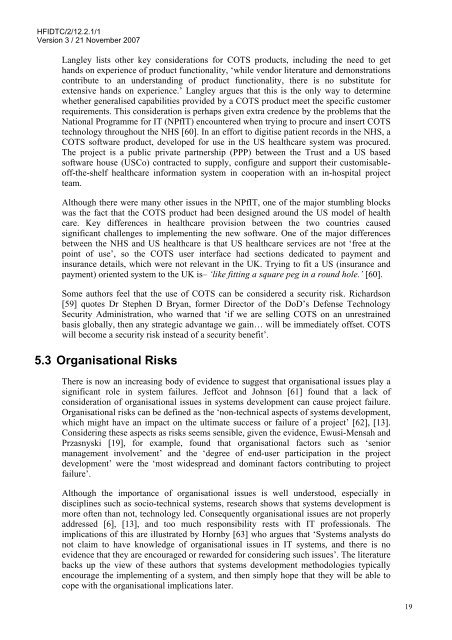The Impact of Technology Insertion on Organisations
The Impact of Technology Insertion on Organisations
The Impact of Technology Insertion on Organisations
Create successful ePaper yourself
Turn your PDF publications into a flip-book with our unique Google optimized e-Paper software.
HFIDTC/2/12.2.1/1<br />
Versi<strong>on</strong> 3 / 21 November 2007<br />
Langley lists other key c<strong>on</strong>siderati<strong>on</strong>s for COTS products, including the need to get<br />
hands <strong>on</strong> experience <str<strong>on</strong>g>of</str<strong>on</strong>g> product functi<strong>on</strong>ality, ‘while vendor literature and dem<strong>on</strong>strati<strong>on</strong>s<br />
c<strong>on</strong>tribute to an understanding <str<strong>on</strong>g>of</str<strong>on</strong>g> product functi<strong>on</strong>ality, there is no substitute for<br />
extensive hands <strong>on</strong> experience.’ Langley argues that this is the <strong>on</strong>ly way to determine<br />
whether generalised capabilities provided by a COTS product meet the specific customer<br />
requirements. This c<strong>on</strong>siderati<strong>on</strong> is perhaps given extra credence by the problems that the<br />
Nati<strong>on</strong>al Programme for IT (NPfIT) encountered when trying to procure and insert COTS<br />
technology throughout the NHS [60]. In an effort to digitise patient records in the NHS, a<br />
COTS s<str<strong>on</strong>g>of</str<strong>on</strong>g>tware product, developed for use in the US healthcare system was procured.<br />
<str<strong>on</strong>g>The</str<strong>on</strong>g> project is a public private partnership (PPP) between the Trust and a US based<br />
s<str<strong>on</strong>g>of</str<strong>on</strong>g>tware house (USCo) c<strong>on</strong>tracted to supply, c<strong>on</strong>figure and support their customisable<str<strong>on</strong>g>of</str<strong>on</strong>g>f-the-shelf<br />
healthcare informati<strong>on</strong> system in cooperati<strong>on</strong> with an in-hospital project<br />
team.<br />
Although there were many other issues in the NPfIT, <strong>on</strong>e <str<strong>on</strong>g>of</str<strong>on</strong>g> the major stumbling blocks<br />
was the fact that the COTS product had been designed around the US model <str<strong>on</strong>g>of</str<strong>on</strong>g> health<br />
care. Key differences in healthcare provisi<strong>on</strong> between the two countries caused<br />
significant challenges to implementing the new s<str<strong>on</strong>g>of</str<strong>on</strong>g>tware. One <str<strong>on</strong>g>of</str<strong>on</strong>g> the major differences<br />
between the NHS and US healthcare is that US healthcare services are not ‘free at the<br />
point <str<strong>on</strong>g>of</str<strong>on</strong>g> use’, so the COTS user interface had secti<strong>on</strong>s dedicated to payment and<br />
insurance details, which were not relevant in the UK. Trying to fit a US (insurance and<br />
payment) oriented system to the UK is– ‘like fitting a square peg in a round hole.’ [60].<br />
Some authors feel that the use <str<strong>on</strong>g>of</str<strong>on</strong>g> COTS can be c<strong>on</strong>sidered a security risk. Richards<strong>on</strong><br />
[59] quotes Dr Stephen D Bryan, former Director <str<strong>on</strong>g>of</str<strong>on</strong>g> the DoD’s Defense <str<strong>on</strong>g>Technology</str<strong>on</strong>g><br />
Security Administrati<strong>on</strong>, who warned that ‘if we are selling COTS <strong>on</strong> an unrestrained<br />
basis globally, then any strategic advantage we gain… will be immediately <str<strong>on</strong>g>of</str<strong>on</strong>g>fset. COTS<br />
will become a security risk instead <str<strong>on</strong>g>of</str<strong>on</strong>g> a security benefit’.<br />
5.3 Organisati<strong>on</strong>al Risks<br />
<str<strong>on</strong>g>The</str<strong>on</strong>g>re is now an increasing body <str<strong>on</strong>g>of</str<strong>on</strong>g> evidence to suggest that organisati<strong>on</strong>al issues play a<br />
significant role in system failures. Jeffcot and Johns<strong>on</strong> [61] found that a lack <str<strong>on</strong>g>of</str<strong>on</strong>g><br />
c<strong>on</strong>siderati<strong>on</strong> <str<strong>on</strong>g>of</str<strong>on</strong>g> organisati<strong>on</strong>al issues in systems development can cause project failure.<br />
Organisati<strong>on</strong>al risks can be defined as the ‘n<strong>on</strong>-technical aspects <str<strong>on</strong>g>of</str<strong>on</strong>g> systems development,<br />
which might have an impact <strong>on</strong> the ultimate success or failure <str<strong>on</strong>g>of</str<strong>on</strong>g> a project’ [62], [13].<br />
C<strong>on</strong>sidering these aspects as risks seems sensible, given the evidence, Ewusi-Mensah and<br />
Przasnyski [19], for example, found that organisati<strong>on</strong>al factors such as ‘senior<br />
management involvement’ and the ‘degree <str<strong>on</strong>g>of</str<strong>on</strong>g> end-user participati<strong>on</strong> in the project<br />
development’ were the ‘most widespread and dominant factors c<strong>on</strong>tributing to project<br />
failure’.<br />
Although the importance <str<strong>on</strong>g>of</str<strong>on</strong>g> organisati<strong>on</strong>al issues is well understood, especially in<br />
disciplines such as socio-technical systems, research shows that systems development is<br />
more <str<strong>on</strong>g>of</str<strong>on</strong>g>ten than not, technology led. C<strong>on</strong>sequently organisati<strong>on</strong>al issues are not properly<br />
addressed [6], [13], and too much resp<strong>on</strong>sibility rests with IT pr<str<strong>on</strong>g>of</str<strong>on</strong>g>essi<strong>on</strong>als. <str<strong>on</strong>g>The</str<strong>on</strong>g><br />
implicati<strong>on</strong>s <str<strong>on</strong>g>of</str<strong>on</strong>g> this are illustrated by Hornby [63] who argues that ‘Systems analysts do<br />
not claim to have knowledge <str<strong>on</strong>g>of</str<strong>on</strong>g> organisati<strong>on</strong>al issues in IT systems, and there is no<br />
evidence that they are encouraged or rewarded for c<strong>on</strong>sidering such issues’. <str<strong>on</strong>g>The</str<strong>on</strong>g> literature<br />
backs up the view <str<strong>on</strong>g>of</str<strong>on</strong>g> these authors that systems development methodologies typically<br />
encourage the implementing <str<strong>on</strong>g>of</str<strong>on</strong>g> a system, and then simply hope that they will be able to<br />
cope with the organisati<strong>on</strong>al implicati<strong>on</strong>s later.<br />
19

















